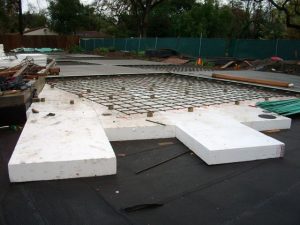Plaza Decks Deconstructed: Why insulation matters in these below-grade applications
With summer drawing to a close, think back on where you soaked up the sunshine this season. Perhaps the beach called your name, or a backyard BBQ supplied some necessary Vitamin D. Or, maybe you and some friends took over a plaza deck, basking in the warmer temperatures atop the idyllic outdoor gathering space.
With the summer sun on your skin you probably gave little thought to what made the enjoyment of these outdoor spaces possible. When it comes to structures like plaza decks, it’s the unseen areas that have a high potential for failure. Along with weathering, below-grade plaza areas are especially susceptible to moisture, thermal effects and wear and tear from heavy foot and, in some cases, vehicle traffic.
Expanded polystyrene (EPS) rigid foam insulation can help building design and construction teams sidestep these hurdles with its superior moisture resistance, thermal performance and compressive strength.

Selecting the right insulation
While extruded polystyrene (XPS) insulation is commonly used in below-grade plaza deck applications, a quick comparison between XPS and EPS insulation reveals that the latter is better suited for keeping water at bay. This factor is important, as freezing and thawing conditions can lead to disintegration of the plaza deck’s foundation.
During a 15-year, in situ third party testing, EPS outperformed XPS by releasing water much faster than its counterpart. An independent testing agency looked at EPS and XPS that had been buried side-by-side on a Minnesota building foundation, and found that EPS was four times drier than XPS. EPS was thereby able to return to high thermal resistance ahead of XPS.
Along with moisture resistance and high R-values, products like Insulfoam XV and Insulfoam R-Tech VII offer compressive strengths up to 60 PSI, the same as XPS. This factor is crucial to preventing crushing and settling in plaza decks.
And for building professionals looking at the bottom line, some EPS options like Insulfoam have lower material costs at all densities when set against equivalent XPS products.
Further considerations
What’s more, EPS insulation solutions afford considerable time and labor savings.

Some manufacturers now offer simple, single layer panels of EPS insulation up to 40” thick. Unlike complicated EPS filler panel systems, construction crews can install these lightweight panels easier and faster, and the process involves fewer bodies to get the job done.
For plaza deck projects with green building considerations, it’s worth noting that EPS can contribute towards LEED credits. The rigid foam insulation does not contain any ozone-depleting blowing agents, dyes or formaldehyde; may contain recycled material; and is 100% recyclable if it’s ever removed or replaced. EPS’ mold-resistant properties also contribute to cleaner air.
The total plaza deck solution
While the right insulation is a key part of any plaza deck’s long-term performance and success, it is just one piece of the puzzle. The ideal solution for these complicated below-grade applications is when manufacturers come together to provide a full system. A full system approach offers single source warranties and simplified ordering, while combining multiple products in a unified way for high performance. For example, Insulfoam EPS rigid insulation’s waterproofing power multiples when working with CCW 500R Hot Applied (liquid membrane system with waterproofing protection) and CCW MiraSEAL Cold Applied (modified polymer that cures to form a waterproof membrane) systems on plaza decks.

